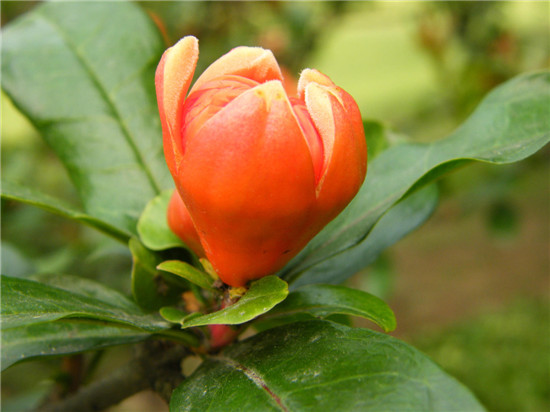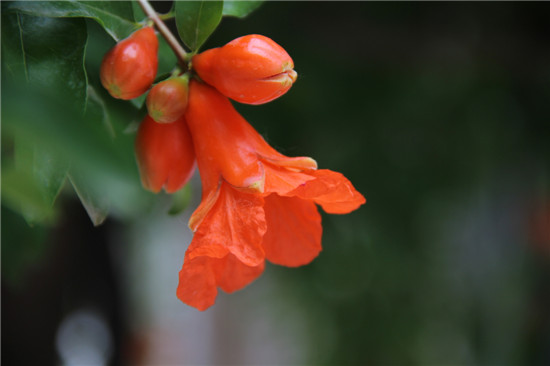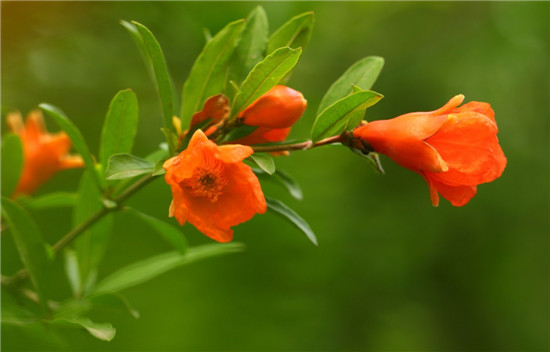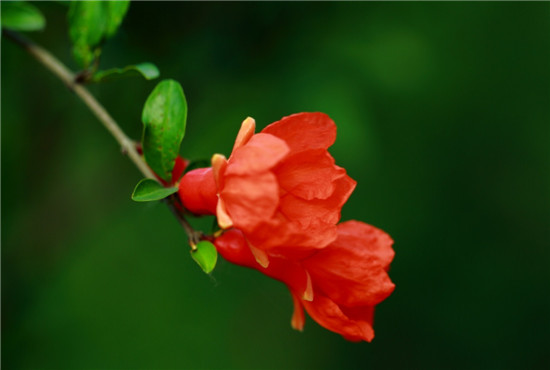Measures for the management of daily culture of pomegranate flowers
Pomegranate flowers are often used as ornamental plants because of their beautiful appearance, waiting for the flowers to bloom and mature. Next, let's take a look at the daily planting management of pomegranate flowers.

Pomegranate flowers can observe both flowers and fruits, small pots can be used for windowsill, balcony and residence furnishings, large pots can be arranged in public places and meeting places, and pomegranate is suitable for the greening configuration of scenic spots. As a medicine, pomegranate has a long history and has been recorded in all kinds of ancient medical books. Through clinical practice, doctors of all ages believe that pomegranate is cool and has the effects of clearing heat, detoxification, invigorating stomach, moistening lungs, astringent intestines, hemostasis and so on.
Among them, pomegranate peel is the most commonly used in medicine, which is used after stir-frying. Pomegranate flower has the effect of stopping nasal obstruction, hematemesis and traumatic bleeding, and can also treat excessive. External use can treat otitis media. Pomegranate tender leaves can strengthen stomach and intestines, eliminate food accumulation, aid digestion, and can be used externally to treat eye diseases and skin diseases.
According to modern medical research, pomegranate peel contains "pomegranate root peel", which can inhibit all kinds of bacilli and skin bacteria. Sour pomegranate contains more ravages, has convergence germicidal effect, can treat diarrhea, thorns, and can appetizer, aid digestion. The root bark of the pomegranate tree has a saddle and has the effect of repelling worms and roundworms.

How to grow pomegranate flowers
1. Planting
Pomegranate planting can be carried out all the year round, especially in early spring and autumn. It is said that it is planted in spring in the north and autumn in the south. It is appropriate to select high-quality seedlings with complete root system, full bud eyes and smooth stem, which can stir the soil until it is mature, remove sundries, change new soil, dig to 50 square meters, bury it deep, reach 0.6-0.8 meters in length, and apply 25-50 kilograms of organic fertilizer, which is fully mixed with topsoil and backfilled.
2. Water and fertilizer management
(1) moisture
Irrigation and drainage is said, that is, the pomegranate needs to be irrigated during the critical period, and the soil moisture should be 60-80%, while it should also be flexibly controlled in other periods. These three key periods are budding stage, fruit expansion stage and pre-defoliation stage. Because pomegranate is resistant to drought and waterlogging, it is also necessary to pay attention to drainage treatment to prevent poor growth of pomegranate caused by waterlogging.
(2) fertilization
In the year of planting, additional fertilizer is needed, which is mixed with 1-2 kg of cooked manure water and a small amount of urea, and applied to the soil. Autumn leaves also need to be fertilized, the general practice is to dig a good ring ditch, topdressing 20-30 kg. Fertilization is also needed in the full fruit period, and rotten manure water is applied in Shupan hole for 3-4 times. It is also necessary to pay attention to topdressing in the growing season, which is usually dominated by nitrogen fertilizer, followed by phosphorus and potassium fertilizer, and pay attention to controlling the concentration of fertilizer.

3. Shaping and pruning
Pomegranate likes light, so considering its light transmission performance, in addition, of course, we should also pay attention to ornamental. Therefore, attention should be paid to ensuring a certain shape when shaping and pruning. For example, natural happy shape, "V" shape and so on.
The principle of pomegranate pruning is: visible never die, invisible do not know chaos. Therefore, these branches and leaves should be carried out in accordance with this principle, so as to make their strong branches have room to grow, while no use of space should be dealt with in time.
Culture and management methods of pomegranate flowers
1. Change the basin before sprouting in early spring, pomegranate does not have strict requirements on soil, except for cats do not like heavy soil slope, can adapt. Potted soil is best to use fertile, loose, well-drained soil. The pomegranate usually changes the basin once in 2-3 years. Make proper pruning before changing the basin. The buds should be watered once before germination and should be cultured in the sun and watered properly after germination. Proper fertilization should be applied when the growth is exuberant, and the flowering should be arranged in a place with light to watch. Pomegranate can send new shoots 2-3 times a year and bloom 2-3 times a year. After each flowering, pomegranate should be properly heart-picked, which is beneficial to the formation of new flower buds. If the fruiting pomegranate should remove the tubular flowers (no fruiting flowers) and leave the bell flowers. Double pomegranate flowers are mostly sterile, so there is no need to sparse flowers.

two。 Pomegranate is resistant to high temperature and scorching sun in summer. Bree should watch it on the balcony with light to maintain sufficient light. Due to the large amount of water evaporation when the temperature is hot, it should be watered in time. When watering pomegranates in summer, do not spray water to the leaves and around, should maintain a dry environment, otherwise it is easy to cause poor pollination of pomegranates and few fruits.
3. The fruit of pomegranate in autumn is numerous, red and attractive, and its cloth can be placed in a semi-shady or bright place to make the basin soil more than a thousand. No results potted plants and bonsai pomegranates should be cultivated in the sun and keep the potted soil to be dormant after the temperature is getting cooler.
4. Dormant in winter. Pomegranate is more hardy after dormancy, pomegranate potted plants and bonsai should pay attention to prevent the roots from freezing, and can be fed in a closed balcony of about 0 ℃ to keep the basin soil dry and not dry. Results Pomegranate should keep a certain temperature and proper light, which can prolong the viewing period.
The above is all the contents of the pomegranate flower daily culture management methods that I have summarized for you. I hope this article can help you. Please continue to follow us.
4. Dormant in winter. Pomegranate is more hardy after dormancy, pomegranate potted plants and bonsai should pay attention to prevent the roots from freezing, and can be fed in a closed balcony of about 0 ℃ to keep the basin soil dry and not dry. Results Pomegranate should keep a certain temperature and proper light, which can prolong the viewing period.
The above is all the contents of the pomegranate flower daily culture management methods that I have summarized for you. I hope this article can help you. Please continue to follow us.
Related
- Wuhan Hospital Iron Tree Blooming Result Was Instantly Frightened by the Gardener Master
- Which variety of camellia is the most fragrant and best? Which one do you like best?
- What is the small blue coat, the breeding methods and matters needing attention of the succulent plant
- Dormancy time and maintenance management of succulent plants during dormancy
- Minas succulent how to raise, Minas succulent plant pictures
- What are the varieties of winter succulent plants
- How to raise succulent plants in twelve rolls? let's take a look at some experience of breeding twelve rolls.
- Attention should be paid to water control for succulent plants during dormant period (winter and summer)
- Watering experience of twelve rolls of succulent plants
- Techniques for fertilizing succulent plants. An article will let you know how to fertilize succulent plants.



